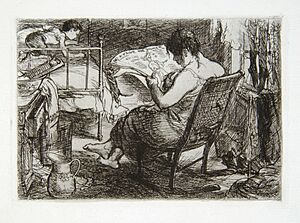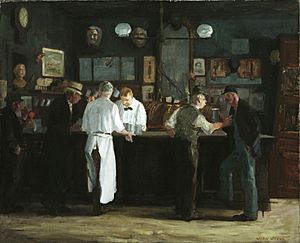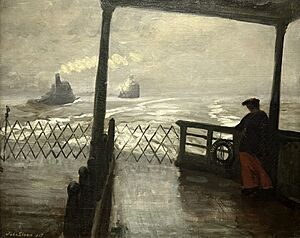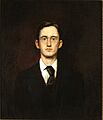John Sloan facts for kids
Quick facts for kids
John Sloan
|
|
|---|---|
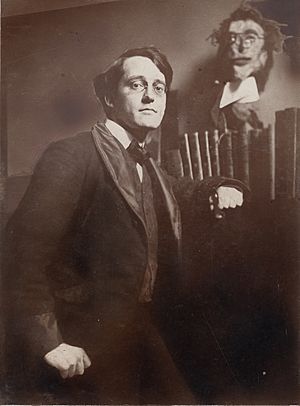
Sloan in 1891
|
|
| Born |
John French Sloan
August 2, 1871 Lock Haven, Pennsylvania, U.S.
|
| Died | September 7, 1951 (aged 80) Hanover, New Hampshire, U.S.
|
| Education | Pennsylvania Academy of the Fine Arts |
| Known for | Painting, Etching |
|
Notable work
|
McSorley's Bar, (1912), Sixth Avenue Elevated at Third Street, (1928), Wake of the Ferry, (1907), and Hairdresser's Window, (1907) |
| Movement | Ashcan School |
| Awards | Gold Medal (1950) |
John French Sloan (born August 2, 1871 – died September 7, 1951) was an American painter and etcher. He is known as one of the artists who started the Ashcan School of American art. He was also part of a group called The Eight. Sloan is famous for his paintings of city life, especially in New York City. He often showed scenes he saw from his studio window. Many people consider him the most important artist of the Ashcan School. He was also a realist painter who believed in Socialism, but he kept his art separate from his political views.
Contents
About John Sloan
John Sloan was born in Lock Haven, Pennsylvania, on August 2, 1871. His father, James Dixon Sloan, was artistic but had jobs that didn't always pay well. His mother, Henrietta Ireland Sloan, was a schoolteacher from a wealthy family. John grew up in Philadelphia, Pennsylvania, and lived there until 1904. He then moved to New York City. John and his two sisters, Elizabeth and Marianna, were encouraged to draw and paint from a young age. In 1884, he went to Central High School in Philadelphia. His classmates included William Glackens and Albert C. Barnes, who also became famous.
Early Life and Art Training
In 1888, when John was sixteen, his father became very ill and could not work. John had to leave school to help support his family. He worked as an assistant at Porter and Coates, a bookstore that sold art prints. His job was easy, so he had lots of time to read books and look at the prints. Here, Sloan made his first drawings, copying works by famous artists like Dürer and Rembrandt. He also started making etchings, which were sold in the store.
In 1890, Sloan got a better job offer from A. Edward Newton, who had opened his own stationery store. At Newton's, Sloan designed greeting cards and calendars. He also kept working on his etchings. That same year, he took a night drawing class at the Spring Garden Institute. This was his first official art training.
In 1891, Sloan left Newton's to work for himself as an artist, but he didn't earn much money. In 1892, he started working as an illustrator for The Philadelphia Inquirer newspaper. Later that year, Sloan began taking evening classes at the Pennsylvania Academy of the Fine Arts. He studied with the realist painter Thomas Anshutz. His old schoolmate, William Glackens, was also in his class.
Meeting Robert Henri and The Eight
In 1892, Sloan met Robert Henri, a talented painter and a strong supporter of artistic freedom. Henri became Sloan's mentor and close friend. Henri encouraged Sloan's drawing and eventually convinced him to start painting. They both believed in a new style of art called the "Ashcan School." In 1893, Sloan and Henri started a short-lived art club called the Charcoal Club. Other members included Glackens, George Luks, and Everett Shinn.
Towards the end of 1895, Sloan left The Philadelphia Inquirer to work for The Philadelphia Press. This job gave him more time to paint. Henri often sent Sloan pictures of European artists like Manet, Hals, Goya, and Velázquez.
In 1898, Sloan met Anna Maria (Dolly) Wall. They fell in love and married on August 5, 1901. Dolly was a loving partner who always believed in Sloan. However, she sometimes struggled with her health, which caused difficult times for them. A close friend who helped them through these times was the artist John Butler Yeats, father of the poet William Butler Yeats.
Moving to New York City
By 1903, Sloan had painted almost sixty oil paintings, but he was not yet famous. In April 1904, he and Dolly moved to New York City. They found a place in Greenwich Village. Here, he painted some of his most famous works, like McSorley's Bar, Sixth Avenue Elevated at Third Street, and Wake of the Ferry. He painted more and more, but didn't sell many paintings. He still earned money by drawing weekly puzzles for The Philadelphia Press until 1910. By 1905, he also drew illustrations for books and magazines like Collier's Weekly and Good Housekeeping.
In 1908, Sloan took part in an important art show at the Macbeth Galleries. This show included four other artists from the Philadelphia Charcoal Club (Henri, Glackens, Luks, and Shinn). It also featured three artists with a different, more impressionistic style: Maurice Prendergast, Ernest Lawson, and Arthur B. Davies. This group became known as "The Eight." The show was a way to challenge the strict rules of the National Academy of Design. Sloan then organized a traveling exhibition of these paintings, which went to several cities. This show made people talk about new ways of making art and what could be considered art.
Sloan started a diary in 1906. He hoped Dolly would secretly read it and feel better about her fears that he would leave her. The diary grew to cover his life until 1913. When it was published in 1965, it gave researchers a detailed look into Sloan's activities and the art world before World War I.
Political Views and Teaching
Sloan became unhappy with the government, which he felt favored the rich. So, in 1910, he joined the Socialist Party. Dolly Sloan also became involved in Socialist projects. John Sloan became the art editor of The Masses magazine in 1912. He also drew powerful anti-war and anti-rich drawings for other socialist magazines. Sloan did not always put clear political messages in his art, as he wasn't comfortable with pure propaganda. He left The Masses in 1916 because he felt it was becoming too strict. He was never a supporter of the Communist Party, but he hoped the Soviet Union would create a fair society. Throughout his life, he supported left-wing political ideas and strongly disliked the unfairness of the American economic system. He was also against the United States joining World War I.
In 1913, Sloan painted a very long backdrop for the Paterson Strike Pageant. This was a performance art show about politics, organized by activist John Reed. The play was a benefit for striking silk mill workers in Paterson, New Jersey. It took place in Madison Square Garden and had over 1,000 people taking part. Sloan is known as the "premier artist of the Ashcan School" who painted the lively energy of New York City in the early 1900s.
Also in 1913, Sloan was part of the famous Armory Show. He helped organize it and showed two paintings and five etchings. In the same year, a collector named Albert C. Barnes bought one of Sloan's paintings. This was only the fourth painting Sloan had ever sold. Seeing the European modern art at the Armory Show made Sloan slowly change his style. He started moving away from the realistic city themes he had painted for ten years. In 1914–15, he spent summers in Gloucester, Massachusetts. There, he painted landscapes outdoors in a new, more flowing and colorful style. He was influenced by artists like Van Gogh and the Fauves.
Starting in 1914, Sloan taught at the Art Students League. For the next eighteen years, he was a popular but sometimes unusual teacher. Sloan also taught for a short time at the George Luks Art School. His students respected his knowledge and honesty, but they were sometimes afraid of his sharp comments. He was a well-known painter but had sold few paintings. He told his students, "I have nothing to teach you that will help you to make a living." He didn't like artists who only cared about their careers. He told his students to find joy only in the act of creating art.
Later Life and Legacy
The summer of 1918 was his last in Gloucester. For the next thirty years, he spent four months each summer in Santa Fe, New Mexico. The desert landscape there inspired him to focus on painting shapes and forms. Still, most of his work was done in New York. Because of his time in the Southwest, he and Dolly became very interested in Native American art and traditions. Back in New York, they became supporters of Native American artists. In 1922, he organized an exhibition of Native American art in New York. He also supported the work of Diego Rivera, calling him "the one artist on this continent who is in the class of the old masters." The Society of Independent Artists, which Sloan helped start in 1916, gave Rivera and José Clemente Orozco their first show in the United States in 1920.
In 1943, Dolly Sloan died. The next year, Sloan married Helen Farr, a former student who was forty years younger than him. They had been romantically involved in the 1930s. On September 7, 1951, Sloan died of cancer while on vacation in Hanover, New Hampshire. The next January, the Whitney Museum of American Art held a successful show of his art. Helen Farr Sloan later became a well-known giver to charity. She made sure his unsold paintings were given to major museums across the country.
Sloan's Art Style

John Sloan is strongly connected to the Ashcan School because he painted city crowds, apartment rooms, shop girls, and hairdressers. However, Sloan disliked the term "Ashcan School." He felt it grouped too many different painters together. He also thought it made people focus on the subject of the painting instead of the art style. He believed it suggested that artists were trying to expose problems, which he didn't like. Sloan felt that good artists should be admired for their skillful brushwork, colors, and how they arranged their paintings.
Unlike Robert Henri, Sloan was not a fast painter. He worked carefully on his art. Henri once joked that "Sloan" was "the past tense of 'slow.'" When Sloan and Glackens worked at The Philadelphia Inquirer, Glackens usually got the reporting jobs because he was quicker at making sketches. Sloan's careful way of sketching also applied to his painting. He would observe city life and then paint it from memory, rather than sketching directly on the street. His paintings often look like quick drawings, but they were carefully thought out. This was a key part of his style, fitting with the Ashcan School's goal of making a subject feel immediate, like a snapshot.
Sloan often painted city people interacting in private moments. One of his students said he painted "street scenes, restaurant life, paintings of saloons, ferry boats, roof tops, back yards, and so on through a whole catalogue of commonplace subjects." Like Edward Hopper, Sloan often used the view from a window in his paintings. This helped him focus closely on his subject and observe without being seen. He wrote in his diary in 1911, "I am in the habit of watching every bit of human life I can see about my windows, but I do it so that I am not observed at it ... No insult to the people you are watching to do so unseen." Sloan's focus on small moments in the city reminds us of the storytelling in realist books and Hollywood films, which he enjoyed.
Sloan was described as an "early twentieth-century realist painter who believed in Socialism and used his artistic talents to support those beliefs." However, whenever people asked Sloan about the social meaning of his paintings or his strong belief in Socialism, he said his paintings were made with "sympathy, but no social consciousness ... I was never interested in putting propaganda into my paintings, so it annoys me when art historians try to interpret my city life pictures as 'socially conscious.' I saw the everyday life of the people, and on the whole I picked out bits of joy in human life for my subject matter."
In the late 1920s, Sloan changed his painting style and stopped painting city scenes. This happened just as his city pictures were finally becoming popular enough for him to make a good living. Instead, he started painting nudes and portraits. This independent choice surprised his art dealer, Charles Kraushaar. Sloan didn't like the quick, spontaneous painting style of artists like Manet and Hals, or even Robert Henri and George Luks. Instead, he went back to the older methods of underpainting and glazing used by old masters like Andrea Mantegna. This was an unusual choice. The paintings he made with this new style, which often used crisscross lines to define shapes, have never been as popular as his early Ashcan works.
Sloan's Legacy
John Sloan's paintings are in almost all major American museums. Some of his most famous works include Hairdresser's Window (1907) at the Wadsworth Atheneum, The Picnic Ground (1907) at the Whitney Museum of American Art, The Haymarket (1907) at the Brooklyn Museum, McSorley's Bar (1912) at the Detroit Institute of Arts, and The White Way (1927) at the Philadelphia Museum of Art. In 1971, his painting Wake of the Ferry (1907) was even put on a U.S. postage stamp to honor him.
Many artists studied with Sloan, including Peggy Bacon, Alexander Calder, Reginald Marsh, and Barnett Newman. In 1939, he published a book of his teachings and wise sayings called Gist of Art. This book stayed in print for over sixty years.
The art critic Robert Hughes praised Sloan's art for its "honest humaneness, a frank sympathy, a refusal to flatten its figures into stereotypes of class misery." He added that Sloan "saw his people as part of larger totality, the carnal and cozy body of the city itself." Art historian Milton Brown called Sloan "the outstanding figure of the Ash Can School." To his friend, the painter John Butler Yeats, and to art critic Henry McBride, he was like "an American Hogarth," referring to a famous British painter known for his social scenes.
The lobby of the United States Post Office in Bronxville, New York, has a mural painted by Sloan in 1939. It is called The Arrival of the First Mail in Bronxville in 1846. This mural was ordered by the government's art program. The post office and mural were added to the National Register of Historic Places in 1988.
Images for kids
-
Self-portrait, 1890. Sloan painted this on a window shade, teaching himself to use oil paints.
See also
 In Spanish: John French Sloan para niños
In Spanish: John French Sloan para niños


